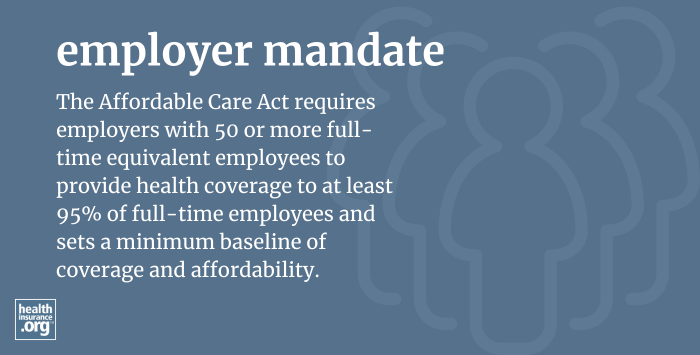
What is the employer mandate?
The Affordable Care Act requires employers with 50 or more full-time equivalent employees to provide health coverage to at least 95% of full-time employees and sets a minimum baseline of coverage and affordability. Employers who do not comply face annual penalties if any of their employees end up qualifying for premium tax credits (subsidies) in the Marketplace.
How do the employer mandate penalties work?
There are two types of penalties under the employer mandate. One is for large employers that don't offer coverage at all, and the other is for large employers that offer coverage that doesn't provide minimum value and/or isn't considered affordable.
In both cases, the penalty is only triggered if at least one full-time (30+ hours per week) employee receives a premium tax credit in the marketplace.
The penalty for offering inadequate or unaffordable coverage can never be greater than the penalty for not offering coverage at all.
How much are the employer mandate penalties?
As of 2024, the employer mandate penalties are as follows:1
- For a large employer that doesn't offer coverage at all: $2,970 multiplied by 30 less than the total number of full-time employees.
- For a large employer that offers coverage that isn't considered affordable and/or doesn't provide minimum value: $4,460 multiplied by the number of full-time employees who receive a premium tax credit in the marketplace (but this penalty will not exceed the amount of the other penalty, so that will be used instead if it's less).
For 2025, the employer mandate penalties will decrease for the first time, and will be as follows:2
- For a large employer that doesn't offer coverage at all: $2,900 multiplied by 30 less than the total number of full-time employees.
- For a large employer that offers coverage that isn't considered affordable and/or doesn't provide minimum value: $4,350 multiplied by the number of full-time employees who receive a premium tax credit in the marketplace (not to exceed the amount of the other penalty).
These amounts started at $2,000 and $3,000, respectively in 2015. But they are indexed each year by the IRS, and have thus grown over time (see FAQ 55 in this link for details). But as noted above, they are decreasing in 2025, for the first time.
Footnotes
- Revenue Procedure 2023-17. Internal Revenue Service. Accessed January 2024. ⤶
- Revenue Procedure 2024-14. Internal Revenue Service. Accessed Aug. 23, 2024 ⤶


